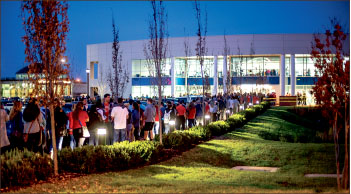Prepared for terror

Students and officials participated in a bioterrorism simulation on campus
A simulated bioterrorism event was held Saturday, April 9 at the LaHaye Ice Center to give students and officials a hands-on experience in dealing with a chemical terrorist attack.
Liberty University’s Department of Biology & Chemistry hosted the event.
Members of the Virginia State Police, the U.S. Army National Guard, the Department of Defense, the City of Lynchburg Fire Department and a representative from the FBI were also involved.
Liberty University Police Department (LUPD) was a part of the event to both learn from the assessment and to control the surrounding area, including traffic control and parking. Close to 25 emergency vehicles were on the scene.
“It was an opportunity to offer training not only to students, but to those agencies that are first responders,” Dr. J. Thomas McClintock, a professor of biology at Liberty and the host of the event, said. “They could train each other while training students.”

Prepare — Students used the LaHaye Ice Center to practice the disaster simulation. Photo credit: Leah Seavers
McClintock explained that the main focuses of the experience were both to train students and to allow them to use what they have learned in the classroom in a hands-on environment.“We simulated a bioterrorist attack so that the first responders could come and work together in a non-emergency environment,” McClintock said.
“They learn real-world scenarios but in a non-threatening situation.”
Setup for the event began around 7:30 a.m. when the entire LaHaye ice rink was fogged.
Students arrived on the scene at 9 a.m. and worked until approximately noon to clear the area of biochemicals.
In a real life situation, it would take at least 24 hours to completely clear the scene.
Biological agents placed a talcum powder-based substance at three targets in the area, but everything was completely controlled. Students were given monitors that would not allow them to get too close to the substance.
The simulation event was open to students in the forensic science program, criminal justice program, and to biology and chemistry students. Several students from the nursing program were also involved.
“It gives students the opportunity to see what is needed and all the different skill sets that were required,” McClintock said. “It also gives an idea of the different positions and different careers that are involved.”
While using millions of dollars’ worth of equipment, students were able to learn what it takes to be a first responder, what skill sets and training are needed, and what types of agencies are involved in this type of terrorist attack.
This is the second year the Liberty Department of Biology & Chemistry has hosted the event on Liberty’s campus. In 2015, the simulation was held inside of the Vines Center.
The bioterrorism simulation came a week after a suspicious package was found on Liberty’s campus. The object was determined to be a piece of HVAC equipment.
McClintock explained that the event had already been in the works prior to the discovery of the package. He said the incident with the package was an example of how relevant these types of cases are in the world today.
“I think it shows the need for those agencies to have the training, and to know how to respond to real-world experience,” McClintock said. “It is happening all around us.”
Coleman is a news reporter.
